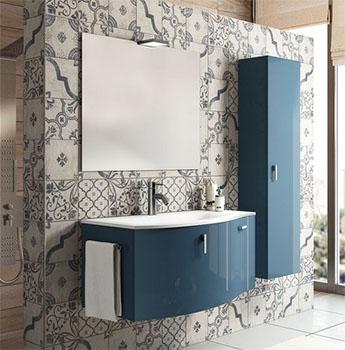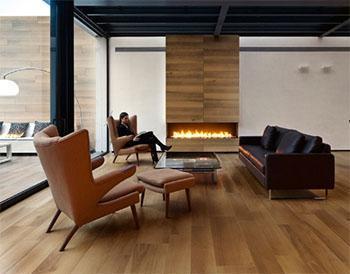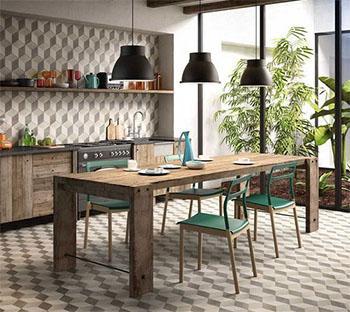Advantages of the porcelain stoneware
Post from EditorialsThe porcelain is very robust and versatile, suitable for indoor and outdoor use and above all able to imitate perfectly the texture of different materials.
Features and advantages of porcelain stoneware
 The porcelain stoneware is a ceramic material very resistant obtained by baking at very high temperatures (1150-1250 ? C) a mixture of clay, sand, kaolin (white clay) and finely ground feldspar and subsequently pressed into molds with the shape of the single tile.
The porcelain stoneware is a ceramic material very resistant obtained by baking at very high temperatures (1150-1250 ? C) a mixture of clay, sand, kaolin (white clay) and finely ground feldspar and subsequently pressed into molds with the shape of the single tile.
During the baking takes place the ceramization/ vitrification, with which the material melts, decreasing in size and decreasing in a decisive way its porosity.
The end result is a tile (with varying shapes and sizes ranging generally between 5 and 180 cm) with a surface very little porous, non gel and very resistant to scratches and abrasions: the first samples - typically small, rectangular, red and almost translucent surface - were in fact mainly used in the paving of porches, patios, terraces and areas frequented as schools, hospitals and railway stations.
Currently, technological progress has greatly improved the performance and especially the appearance of the material, greatly expanding both its scope (private homes and environments valuable as hotels, restaurants, spa and fitness centers), and the range of products available on the market.
Simulate a different material
 One of the most appreciated features of the porcelain is now its ability to imitate perfectly the texture of any material, and in particular the wood grain: in fact, with the new processes of reproduction of the images, on each tile can be printed a photograph in high resolution of the desired material, with a very realistic result.
One of the most appreciated features of the porcelain is now its ability to imitate perfectly the texture of any material, and in particular the wood grain: in fact, with the new processes of reproduction of the images, on each tile can be printed a photograph in high resolution of the desired material, with a very realistic result.
Lately, one of the most appreciated features of porcelain stoneware is the ability to interpret and reproduce perfectly the texture of any material, starting with the wood grain: in fact, thanks to the growing technological development of the digital printing, you can recreate on the tiles the same surface characteristics of any element, combining aesthetic results in realistic and surprising technical and functional qualities and high level.
One of the most common applications of this technology is, in fact, the production of tiles inspired by wood, produced in sizes typical of very long and thin parquet and colonial planks.
Ceramiche Caesar offers laths of various sizes of 120x14,7, 120x20 and 120x30 cm that reproduce the appearance of various woods, including walnut, oak and hickory or walnut.
In addition, to meet all demands Caesar has proposed various collections of porcelain tiles that interpret different aspects: from natural stones (especially marble, gneiss, quartz and travertine), cement, metal.
Once you laid in the correct mode depending on the intended use (indoor, outdoor, public places, private residences, etc.), the solutions of ceramics Caesar furnish individually each environment, ensuring better aesthetic of its collections and all the material quality of the porcelain made in Italy.
Simplicity and elegance
 Those who prefer to show the true face of porcelain, can choose among numerous mono-colored tiles in the most varied colors and sizes: from the classic square with sides of 30 cm, a small rectangular tiles or ultimately to larger formats of form again square or rectangular.
Those who prefer to show the true face of porcelain, can choose among numerous mono-colored tiles in the most varied colors and sizes: from the classic square with sides of 30 cm, a small rectangular tiles or ultimately to larger formats of form again square or rectangular.
The latest trends of interior design are in fact oriented towards minimalism, simplicity and the use of neutral colors: exemplary in this regard is the Collection Greiss by the Company Imola Ceramica.
Particularly suitable for bathroom furniture and the construction of floors in large halls, including large format glazed tiles in the colors sand, pearl gray and charcoal gray: if emplaced with thin joints (about one millimeter) and stucco in tone with the color of the material, you will have the illusion of a beautiful monolithic floor.
Reinterpret established traditions
 Another trend proposes the restoration and modern reinterpretation (and with new materials and production techniques, which enable longer-lasting results and much less expensive than the old unique pieces made by hand by skilled craftsmen) tradition now well established and continues to great charm.
Another trend proposes the restoration and modern reinterpretation (and with new materials and production techniques, which enable longer-lasting results and much less expensive than the old unique pieces made by hand by skilled craftsmen) tradition now well established and continues to great charm.
In the catalog by Company IPERCERAMICA we find for example the Epoque Collection, a line of tiles inspired by the Provencal tiles and azuleios.
Small (20x20 cm) and square shape, are suitable for floors and walls. Also, since each sample has a different design, and are available three colors (blue, charcoal and dove gray), there are two design solutions: choosing tiles with the same ornamental motif can in fact get decorations similar to those in vogue in the years 70, while placing them randomly and appropriately varying the colors can be called some recent trends in interior design, offering the construction of floors and coating with old tiles which are heterogeneous.
The same company also offers a model Tredi Sabbia, an inlay in neutral colors and hexagonal shape, that when combined in a modular composition comprises an interesting pattern with perspective cubes.
It is an optical illusion very impressive and of ancient origins, visible for example in numerous rich Roman houses (including the House of the Faun in Pompeii) and in the frescoed facade of a small house in the late medieval old town of Spilimbergo in the province of Pordenone.
79735 REGISTERED USERS










